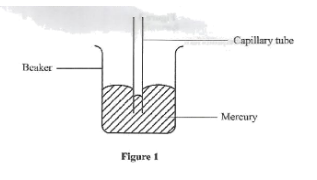
Kenya Certificate of Secondary Education
2020 Physics paper 1
SECTION A
1. The diameter of a wire was measured as 2.43 mm. Name the instrument that was used to measure this diameter ( 1 mark)
2. Figure 1 shows a capillary tube dipped in mercury in a beaker.

State with a reason the observation that would be made on the level of mercury in the capillary tube if the temperature of mercury is increased.(2 marks)
3. State the kinetic theory of gases.(1 mark)
4. Figure 2 shows the scale of a measuring instrument.

(a) Determine the reading indicated.(1 mark)
(b) State the physical quantity measured by this instrument.(1 mark)
5. Figure 3 shows a traditional stool resting on a level surface.

(a) ldentify its state of equilibrium.( 1 mark)
(b) State the reason for the answer in (a).( 1 mark)
6. Figure 4 shows a uniform rod AB of length 1m and weight 8N pivoted at 20 cm from one end. It is balanced by supporting it with a string attached to a fixed support.

The tension in the string is 4N. Determine the position of the string from end A. (3 marks)
7. Define cohesive forces.( 1 mark)
8. Two similar containers A and B are filled with equal masses of water at the same temperature Container A is made of copper while container B is made of glass.
Heat is then supplied to the containers at the same rate. State with a reason, the container in which water boils first.(2 marks)
9. Figure 5 shows a roof of a house over which wind is blowing.

It was observed that, when the speed of the wind increased, the roof was blown off. Explain this observation.(2 marks)
10. Figure 6 shows the velocity-time graph of the motion of a stone thrown vertically upwards.

From the graph, determine the maximum height reached by the stone.( 3 marks)
11. It is observed that when methylated spirit is poured on the palm, the palm feels colder as it dries up. Explain this observation.(2 marks)
12. Figure 7 shows a box placed on a weighing balance. The balance is placed on the floor of a lift.

State what would be observed on the reading of the balance when the:
(i) lift is accelerating downwards(1 mark)
(ii) lift moves downwards with a uniform velocity(1 mark)
(iii) lift is accelerating upwards(1 mark)
13. An object placed on the surface of water in a beaker starts to sink immediately. It is observed that it stops sinking when half of its volume is below the water surface. State the reason for this observation.(1 mark)
SECTION B (55 marks)
Answer all the questions in this section in the spaces provided.
14.(a) Figure 8 shows a bucket filled with water and tied to one end of a string which is used to whirl it in a vertical circular path with a uniform speed v.

(i) State two forces acting on the bucket at any instant.(2 marks)
(ii) Explain why the tension is lowest at point A.(2 marks)
(iii) The speed of the bucket is gradually reduced. Explain what is likely to be observed when the bucket is at point A.(2 marks)
(b) A stone of mass 40g is whirled at the end of a string in a horizontal circular path at (b) speed of 12ms-1. (The string and the stone are in the same horizontal plane). If the string is 1m long, determine the tension in the string.(3 marks)
15.(a) Figure 9 shows a setup used by a student to investigate how a siphon works.

(a) State what would be observed when the student sucks the tube at point A and releases it. (2 marks)
(b) Explain the observation in.(2 marks)
(b) Figure 10 shows a test-tube inverted and floating inside a plastic bottle containing some water. The bottle is then sealed.

It is observed that when the sides of the bottle are squeezed, the test-rube sinks. Explain this observation.(3 marks)
(c) A metallic box weighs 188N and measures 10cm by 30 cm by 8 cm. Determine the maximum pressure it can exert when lying on one of its surfaces.(3 marks)
16.(a) Figure 11 shows a setup that can be used to verify Charles’ Law.

(i) Explain how the:
(I) temperature of air in the tube is measured;(2 marks)
(II) volume of air in the tube is measured.(2 marks)
(ii) State how the pressure is kept constant during the experiment.
(iii) State how the measurements in (i) can be used to verify Charles’ law.(3 marks)
(iv) State one precaution that must be taken to ensure that the temperature of air is accurately measured.(1 mark)
(b) A fixed mass of gas initially at 20°C is heated at constant pressure until its volume doubles. Determine its final temperature.(4 marks)
17.(a) Figure 12 shows a simple machine.

On the same figure, mark and label the following parts:
(i) Effort arm(1 mark)
(ii) Load arm(1 mark)
(b) Figure 13 shows a pulley system used to raise a mass of 5 kg through a height of 2 m when a force of 60N is applied. (Acceleration due to gravity g is 10ms-2)

Determine the:
(i) distance moved by the effort;(1 mark)
(ii) work done on the load;(3 marks)
(iii) potential energy gained by the load (g = 10 Nkg-1).(1 mark)
(c) Figure 14 shows a setup that can be used to determine the specific latent heat of vaporisation of water.
A beaker containing some water was placed on a weighing balance and an immersion heater rated 500 W immersed in the water.

The water was then heated until it boiled. When the water started boiling, the initial the balance was reading on noted and the stop watch started immediately.
The final was then noted reading on the balance after a time t seconds.
(i) State how the mass of steam can be measured using this setup.(1 mark)
(ii) Write down an expression for the heat supplied by the heater.(1 mark)
(iii) Determine the specific latent heat of vaporisation of water.(3 marks)
18.(a) State the meaning of the term matter(1 mark)
(b) Its observed that when a liquid is heated its volume increases. Explain this observation using the kinetic theory of matter (3marks)
(c) Figure 15 shows a setup used to study Brownian motion in liquids.

(i) State the function of the hand lens.(1 mark)
(ii) State what is observed on the pollen grains.(1 mark)
(iii) Explain the observation made in (ii).(2 marks)
(iv) State and explain what would be observed on the pollen grains if the water is heated. (3 marks)
